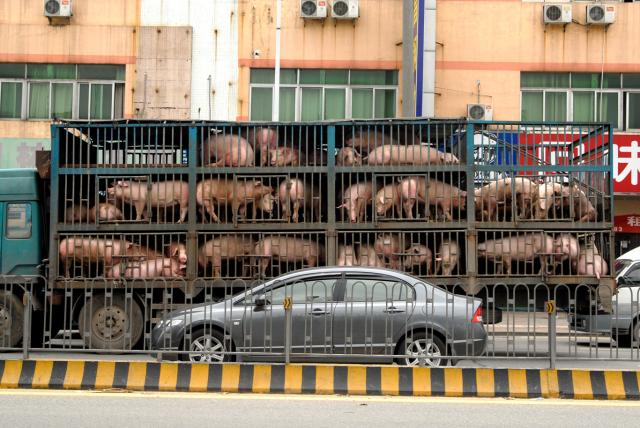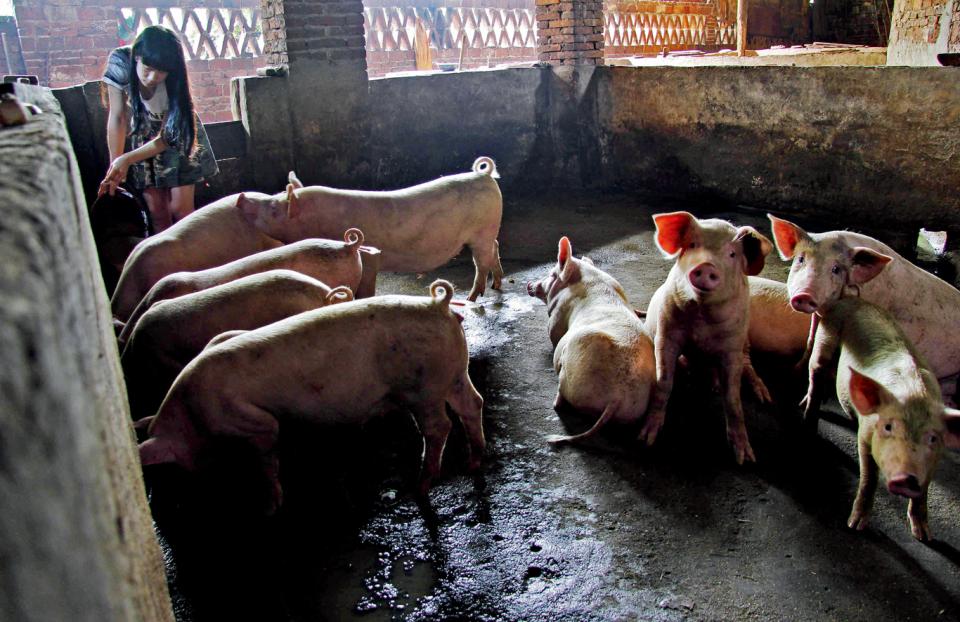Hunan Province has rolled out measures to revive its pig farming industry, and is devolving responsibility to city mayors. Can this approach work?
After months of increases in pork prices starting in March 2019, measures to stabilize prices have begun to take effect, with new provincial-level incentives as well as the continued release of tens of thousands of tons of pork from central reserves.
In Central China’s Hunan Province, after mandatory measures to revitalize the pig farming industry, pork prices dropped for the first time in November, after prices reached record highs nationwide in October.
In September, the mayors of 14 cities in Hunan were given minimum pig production targets for 2019 by provincial authorities. It was the first time that the pig farming industry was ordered to take certain measures to encourage pig production. As the African Swine Fever (ASF) epidemic starts to die down, two-thirds of pig farms, mostly large ones, plan to expand production. But the situation is much bleaker for smaller producers.
Political Assignment
Since the first ASF case in China was reported in August 2018 in Shenyang, Liaoning Province in China’s northeast, the disease quickly spread across all 31 provincial-level regions in the Chinese mainland. In Hunan Province, the first cases were found in late October 2018 in Taojiang County and Taoyuan County. The case in Taojiang saw 31 pigs infected with ASF and 17 dying among a total of 546 pigs in one pig farm, and the case in Taoyuan caused 208 infections and the deaths of 31 out of 268 pigs in a single farm. In the following months, more and more pig farms, large farms and smallholdings reported ASF infections.
Since July and August 2019, dropping temperatures added additional pressure on pig numbers, already decimated by ASF, which resulted in a further decrease in the pig stock in Hunan. Li Tieming, chairman of Jiahe Agricultural Stockbreeding Corporation, told NewsChina that the capacity of the company shrank by 30 percent in July and August. As a large domestic pig breeding enterprise, which started in Hunan but now operates nationwide, Jiahe sold at least one million pigs annually before ASF. The company said that at least 300,000 pigs were culled this year because of ASF.
Large-scale selling and capacity contraction led to a serious decline in pig production in Hunan since the third quarter of this year. Production has fallen to one of the lowest levels in recent years. By the end of September, there were an estimated 26.25 million pigs in the province, a decrease of 33 percent year-on-year. This included a 38.3 percent reduction in breeding sows. In the three months from July to September, the pig herd was reduced by 642.3 million, which exceeded the total reduced number for the first six months.
The contraction in supply resulted in sharp price hikes in pork since August, but this in turn prompted livestock producers, eyeing a return to profits, to boost production and to resume pig sales.
Peng Yinglin, an expert in animal husbandry and veterinary research from Hunan Province, told the reporter that as large pig farms have accumulated knowledge and experience in safety procedures and epidemic control, they are no longer as afraid of ASF as they were at the end of 2018. In fact, they are so confident that they have started stockpiling and restricting supply, which resulted in the price hikes of recent months.
In mid-May, the central government held a teleconference and called for local governments to promote pig farming to stabilize the pork market. On September 10, the State Council announced guidelines for pig production promotion, transformation and upgrading, and set an ambitious goal of achieving 95 percent self-sufficiency in pork supply. For the first time, it stipulated the requirement for each province to secure basic supplies of pork. By the end of October, 18 provinces had published policies to incentivize pig farming.
Hunan, as well as other provinces and regions including Guangdong, Sichuan and Guangxi have distributed their provincial responsibilities to revitalize the pig farming industry to city level governments.
According to the document Policies and Measures on Promoting Pig Production to Ensure Market Supply issued by Hunan Province in mid-September, since 2019, the pig slaughtering rate is to be part of the city mayor responsibility evaluation system, and included in the annual provincial level supervision. All mayors from the 14 cities in Hunan have received detailed “pig farming responsibilities” for 2019.
As pressure filtered down from the central government to provincial levels, and further down to city level governors, action started to be taken everywhere. Yang Jinlong, deputy mayor in charge of agriculture for Hengyang in Hunan told the reporter that the number of conferences on pig farming have multiplied. There must be weekly reports on policy implementation and monthly reports with detailed statistics for sales, number of pigs and number of sows, all submitted to provincial authorities.
According to Yu Kangzhen, vice minister of the Ministry of Agriculture and Rural Affairs, pork production in China was 5,403 tons in 2018, while at the same time imports hit a record high at around 2 percent of the total consumption. “We can only depend on self-sufficiency to solve the pork shortage problem, and that is why the 95 percent target was set,” said Xu Xuyang, director of the Hunan Provincial Livestock and Aquaculture Service Center. “No country can help us solve the issue but ourselves.”
Evaluation
Hunan Province required including the pig slaughter rate into each city mayor’s responsibility evaluation system in 2019. The revitalization of the pig farming industry to secure supply is related to various departments and requires the clarification of new policies. In Yang
Jinlong’s opinion, it will not be easy to ensure the new policy is effective. In late November, a provincial inspection team went to all 14 cities to conduct a 10-day inspection to promote the implementation of the recent policies. Their focus fell on issues including number of pigs, slaughter responsibility fulfillment, the implementation of provincial level policies, how many leading companies in pig farming have been introduced, and how many new projects on pig farming have been implemented.
Qiu Bogen, director of the Animal Husbandry and Veterinary Department of Hunan Agricultural and Rural Department, told NewsChina that the province decided to work on new evaluation standards after the feedback was collected from inspection. He added that the new evaluation and assessment is expected to be implemented for the first time by the end of 2019.
In fact, the mayor’s “(food) basket” responsibility mechanism is not a new thing in China. In 1988, the former Ministry of Agriculture began to implement the Basket Project, which aimed to solve the tight market supply of non-staple food at that time. But it was not until 2017 that the central government finally came out with specific “basket” mayor responsibility system assessment methods. The evaluation criteria included production capacity, market circulation ability, quality and safety supervision ability, regulation and control ability and public satisfaction, which added up to a total of 100 points. Production capability of all non-staple food accounted for 24 points which includes meat production, with pork accounting for eight points.
In October 2018, Hunan Province set up its basket mayor responsibility evaluation measures and stipulated that under the pig farming category, reaching 80 percent of production capacity compared to the previous year would be listed as reaching the target. According to Yang Jinlong, this is the first time Hunan had set detailed targets for the pig farming industry. Qiu Bogen told NewsChina that the evaluation system focuses on incentives. Mayors who can fulfill their responsibilities will earn bonus evaluation points. For those who fail, whether they will be penalized or not may depend on whether they implemented the policies in time.
Incentives
Since September, Hunan started taking action to revitalize its pig farming industry. It offered certain favorable policies, including increasing the government subsidy for insurance for raising a sow from 1,000 to 1,500 yuan (US$141-213) and for one adult pig from 500 up to 800 yuan (US$71-114). Additionally, the provincial government also offers pork producers subsidies for bank loans. Hengyang even promised to provide direct subsidies of 300,000 to 500,000 yuan (US$42,669 to 71,115) to pig farms.
In reality, it is difficult for pig farms to get loans from any banks under the backdrop of the ASF epidemic. Wang Huiyu, bureau chief from the Hengyang Agriculture and Rural Affairs Bureau, added that despite the loan subsidy from the government, authorities cannot force banks to offer credit to pig farms.
Li Kangrong, owner of a private farm of 800 pigs in Leiyang, said he had zero losses during the recent ASF epidemic by setting up effective biosecurity prevention measures. Jiahe’s Li Tieming told the reporter that sufficient prevention measures requires money to improve facilities, which is not possible for smallholders.
For companies who plan to expand their pig farming, despite government encouragement and support, the long existing obstacle of finding proper land remains. Li Xiaoling, chairperson for Hongyun Agriculture Development Company, admitted to NewsChina that the land available and accessible for pig farming purposes is scarce after the central government tightened up regulations on the breeding industry in 2015.
Li estimated it would take between two months to one year before he gets official permission to expand his farm. To address the issue, NewsChina learned that the Hunan government has released new policies on promoting pig supply that include securing land supply for pig farming purposes. According to the new policy, livestock production is to be allowed in certain protected forest areas, which were strictly forbidden in the past. Xu Xuyang pointed out this measure was a breakthrough considering the strict rules that prevented pig farming in these ecological forests. On October 17, Yang Zhenhai, chief of the Animal Husbandry and Veterinary Bureau under Ministry of the Agriculture and Rural Affairs endorsed Hunan’s new policy of “setting up pig farms in the ecological forest” to secure supply.
Another obstacle that pig farming struggles to overcome is people’s protests against the smell. Wang Huiyu said that although the general public wants cheap pork, no one ever wants a farm in their own backyard.
On October 31, the Hengyang government held a ceremony inviting eight leading companies in the pig farming industry to sign preliminary agreements with the city government. The total investment is projected to be up to over 15.4 billion yuan (US$2.19b) which aims to fulfill the supply target of 8.9 million pigs in the near future. “At present, environmental preservation is a political directive, but so is pig farming,” said an official from Hengyang who spoke on condition of anonymity to the reporter.
Recovery of pig production will take time. “Pig farming is not like the manufacturing industry. It has to follow the natural rules,” said He Xiaoxia, an employee from the Hengyang Agricultural and Rural Affairs Bureau. Shortage of sows is a particular problem in Hunan. Liu Shizhen, chief of the bureau, added that now there are more than 400,000 sows in Hengyang and with incentive measures taken by the government, that is expected to increase to 6 to 7 million sows.
Liu also admitted Hengyang aims to sell 5.2 million pigs by the end of this year, but next year would be the real challenge and it will be difficult to fulfill the same target. “The real battle will be next year,” Liu said.

Reviving pig farming and ensuring supply must involve many government departments and a series of new policies

 Old Version
Old Version
